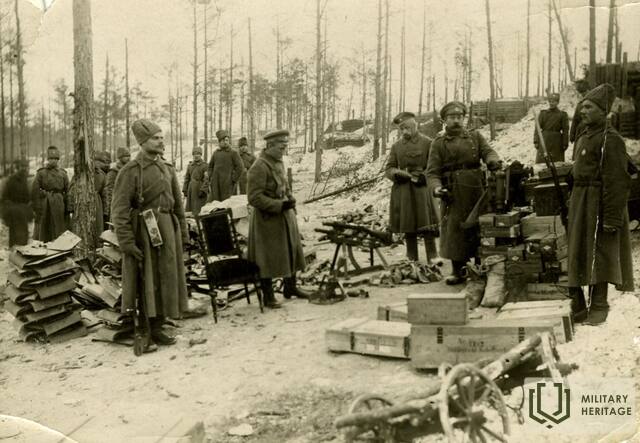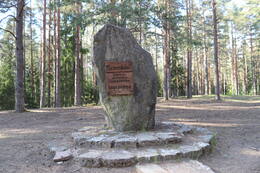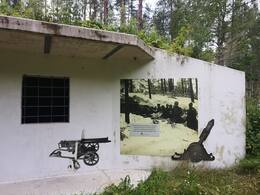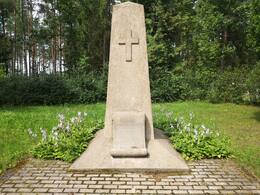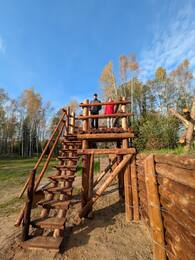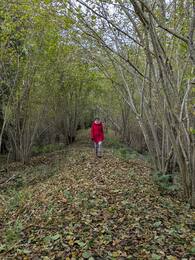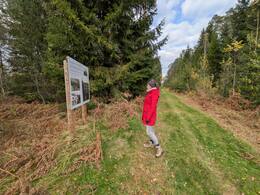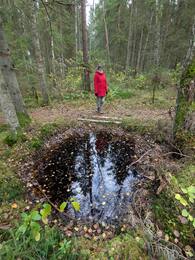Apie kalėdines kovas
Kalėdų mūšiai baigėsi sausio 11 d. Latvijos šauliams trečiąją mūšio dieną pavyko užimti gerai įtvirtintą vokiečių armijos poziciją – Ložmetējkalnu. Kalėdų mūšių kaina buvo labai didelė. Šimtai Latvijos ir kitų Rusijos armijos kareivių žuvo bandydami išstumti vokiečius iš jų pozicijų. Pasakotojas vaizdžiai aprašo mūšio lauko scenas pasibaigus Kalėdų mūšiams.
„Kitą naktį mūsų sanitarai išvedė kritusius nuo priešo spygliuotos vielos tvoros. Ten buvo šimtas penki mūsų pulko vyrai. Pirmosios kuopos vadas kapitonas Lasmanis buvo nutirpęs pakelta dešine ranka, kurioje rado suspaustą ir mesti paruoštą rankinę granatą. Jis krito, į kaktą pataikė dvi kulkos. Mažasis leitenantas Liepinis, besišypsantis kaip nekalta mergaitė, buvo ištrauktas iš tvoros, pervertas nesuskaičiuojamų kulkų. Mirtinai sužeistas lauko seržantas Ivanovas nusišovė savo pistoletu, o vyresnysis puskarininkis Birnis, taip pat mirtinai sužeistas, išsitraukė kišeninį peilį ir persipjovė sau gerklę.“
Susijusios vietos
Kulkosvaidžio kalnas Tyrelio pelkėje
Kulkosvaidžio kalnas (Ložmetėjkalnas) yra Jelgavos apylinkėse, Valgundės seniūnijoje, šalia automagistralės A9. Tai Pirmojo pasaulinio karo mūšių vieta ir vienintelis valstybinės reikšmės kultūrinis ir istorinis draustinis Latvijoje. Ložmetėjkalnas yra ant Ilgosios kopos, priklausančios Nordekių–Kalnciemo kopagūbriui. Pavadinimas atsirado tais laikais, kai čia buvo įrengti neįveikiami Vokietijos kariuomenės įtvirtinimai, ginami sunkiaisiais kulkosvaidžiais.
Kalėdų mūšiai – vienas žinomiausių ir dramatiškiausių Pirmojo pasaulinio karo įvykių Latvijos istorijoje. 1917 m. Ložmetėjkalną puolė ir užėmė Rusijos kariuomenės latvių šaulių bei sibiriečių daliniai. Jie paėmė į nelaisvę apie 600 priešo karių ir užgrobė vertingų trofėjų. Patys šauliai tvirtino, kad būtent jie nusipelnė vadintis šios aukštumos užkariautojais.
Kulkosvaidžio kalno (Ložmetėjkalno) apylinkėse yra išlikę atminimo ženklai ir kitų čia vykusių mūšių liudijimai. Kasmet sausio mėnesį čia vyksta renginiai, skirti Kalėdų mūšių atminimui. Ši vieta tapo latvių šaulių didvyriškumo ir narsos simboliu. Čia pastatytas 27 m aukščio apžvalgos bokštas, nuo kurio atsiveria Kalėdų mūšių vietos vaizdas.
Buvęs Latvijos kareivių medicinos sandėlis
Įsikūręs Babytės rajone, netoli Antinių karių kapinių ir atnaujintų apkasų.
Pirmojo pasaulinio karo metu nuo 1915 m. šioje teritorijoje buvo įsikūrusios Rusijos imperijos armijos gynybinės pozicijos. 1917 m., per Kalėdų mūšius, šalia Antinių namo buvo įsikūręs 5-ojo Žiemgalos latvių šaulių pulko štabas ir ligoninė su vaistų sandėliu, kuriai vadovavo žymus Latvijos karo gydytojas Pēteris Snīķeris.
Kalėdinių mūšių metu Latvijos šauliai puolė Vokietijos armijos dalinius ypač atšiauriomis ir nepalankiomis sąlygomis. Mūšiuose patirti sužalojimai buvo įvairūs – šautinės žaizdos, sumušimai ir traumos, taip pat nušalimai. Laiku reikėjo suteikti medicininę pagalbą tūkstančiams Latvijos kareivių. Ji buvo organizuojama taip, kad sužeistieji kuo greičiau gautų pagalbą. Mūšio lauke dirbo neginkluoti paramedikai, teikdami pirmąją pagalbą ir išveždami sužeistuosius iš pavojingų vietų. Šalia mūšio laukų buvo įrengti tvarstymo punktai, kur buvo tęsiama priežiūra ir atliekamas triažas. Sunkiau sužeisti kareiviai vežimais ir automobiliais buvo evakuojami į ligonines ar ligonines. Šalia ligoninių buvo įkurtos kapinės, kuriose buvo laidojami nuo sužalojimų mirę asmenys.
Šiandien galite aplankyti senąjį vaistų sandėlį. Netoliese yra Antinių karių kapinės, taip pat rekonstruoti Pirmojo pasaulinio karo apkasai ir slėptuvės. Aplinka tinkama pasivaikščiojimams miške, atskleidžiant ryškius karinio paveldo įrodymus.
Kalėdinių mūšių memorialas Antinu brolių kapinėse
Įsikūręs Babytės rajone, pakelėje, netoli buvusių Antinių namų ir senojo vaistų sandėlio.
Antinių arba Tyrelių karių kapinės buvo įkurtos Pirmojo pasaulinio karo metu. Šioje teritorijoje buvo Rusijos imperijos armijos gynybinės pozicijos. 1917 m., per Kalėdų mūšius, netoliese buvo įsikūręs 5-ojo Žemgalės latvių šaulių pulko štabas, ligoninė su vaistų sandėliu.
1917 m., sausio 5-osios ir 6-osios naktį, apšviečiant aštuoniems didžiuliams laužams, su karine pagarba buvo palaidoti 105 5-ojo žiemgalių latvių šaulių pulko kovotojai. Jie žuvo mūšiuose su vokiečių armija arba mirė nuo žaizdų. Laidojimo ceremonijai vadovavo pulko vadas Jukumas Vācietis. Vėlesniais metais kapinėse buvo laidojami ir kitų Rusijos armijos dalinių kareiviai. 1925 m. kapinėse atidengtas architekto Eiženo Laubės sukurtas paminklas, o teritorija apželdinta. Informacijos apie 3800 kapinėse palaidotų kareivių aptinkama daug kur, tačiau ją reikėtų laikyti mažai tikėtina ir nepatikrinta.
Kalėdų mūšių muziejus
Muziejus, įsikūręs sodyboje „Mangaļi“ Jelgavos apylinkėse, Valgundės seniūnijoje, yra Latvijos karo muziejaus filialas. Jis atidarytas 2005 m. toje vietoje, kurioje per Pirmąjį pasaulinį karą vyko Kalėdų mūšiai. Šiose vietose iki šiol tebėra išlikę išskirtiniai Pirmojo pasaulinio karo įtvirtinimai. Kalėdų mūšių muziejaus ekspozicija yra įrengta autentiškoje vietoje po atviru dangumi. Čia galima pamatyti rekonstruotą įtvirtinimų sistemos fragmentą – lauko slėptuvę ir dalį pirmosios vokiečių gynybos linijos, vadinamos „vokiečių pyli mu“. Tai vienintelis tokio pobūdžio objektas Baltijos šalyse. Kalėdų mūšiai – vienas žinomiausių ir dramatiškiausių Pirmojo pasaulinio karo įvykių Latvijoje. Jie užima ypatingą vietą latvių karo ir kultūros istorijoje. Intensyvūs mūšiai truko šešias dienos ir pareikalavo daug aukų. Šie įvykiai dažniausiai siejami su latvių šaulių puolimu prieš Vokietijos kariuomenę, vykusiu ypač atšiauriomis ir nepalankiomis žiemos sąlygomis. Tai buvo pirmas kartas, kai didelio masto puolimas vyko be artilerijos palaikymo.
Šiuo metu muziejuje eksponuojami mūšių vietose rasti radiniai. Vidaus ekspozicija lankoma nustatytu laiku, o po atviru dangumi esančių įtvirtinimų ekspoziciją galima apžiūrėti kiekvieną dieną. Apylinkėse sudaryti turistiniai maršrutai ir įrengti pažintiniai takai.
Kračių kalnų paminklas
Krāčių kalnynas yra viena didžiausių Litorinos jūros pakrantės kopų. Aukščiausias jos taškas yra 29 m virš jūros lygio ir 26 m virš aplinkinių lygumų. Sakoma, kad Litorinos jūra yra Baltijos jūros, egzistavusios maždaug prieš 7000–5000 metų, pirmtakė.
12-osios Rusijos armijos 6-oji specialioji brigada Kalėdų mūšių metu pradėjo puolimą nuo Krāčių kalvų, turėdama užduotį pralaužti vokiečių frontą nuo Didžiosios Tyrelių pelkės iki Lielupės upės. Per mėnesį trukusius mūšius Rusijos armija užėmė 25 kvadratinių kilometrų plotą, tačiau nuostoliai buvo milžiniški – 45 tūkstančiai žuvusių, sužeistų ir dingusių be žinios kareivių. Latvijos šaulių nuostoliai siekė 9 tūkstančius žuvusių, sužeistų ir dingusių be žinios kareivių. Kalėdų mūšių metu Latvijos šauliai pelnė didžiulę didvyriškų ir šaunių kareivių šlovę, sumokėdami už tai labai didelę kainą – savo gyvybes.
Žuvusiųjų mūšyje atminimui pastatytas paminklas. Kiekvienais metais lapkričio 11 d., Lačplėsio dieną, ir lapkričio 18 d., Latvijos valstybės paskelbimo metines, šioje vietoje uždegamos žvakės žuvusiems didvyriams atminti.
Saugoma gamtos teritorija „Krāčių kalnai“ kaip Litorinos laikotarpio kopų kalva
Vokiečių pylimas
„Vokiečių pylimas“ – tai gynybinis įtvirtinimas, pastatytas Vokietijos armijos ir naudotas per 1916 m. Kalėdų mūšius. Jį sudaro žemių pylimas, sutvirtintas medinėmis konstrukcijomis ir spygliuota viela, sudarantis skydą nuo atakų. Šio tipo įtvirtinimai buvo įprasti Pirmojo pasaulinio karo metu, siekiant sustiprinti fronto linijas ir apsaugoti karius.
„Vokiečių sieną“ galima apžiūrėti einant 7 km ilgio pėsčiųjų maršrutu, kuris prasideda prie Mangalių namų – Kalėdų mūšių muziejaus. Muziejaus apylinkėse – netoliese esančiuose miškuose – palei „Vokiečių sieną“ driekiasi natūralus takas, kuris taip pat yra tvarkomas, tai yra – lengvai prieinamas pėstiesiems. Reikėtų atsižvelgti į tai, kad „Vokiečių siena“ yra po atviru dangumi esantis objektas – gali būti nuvirtęs medis, reljefas nelygus. „Vokiečių siena“ tęsiasi ir toliau į šiaurę bei kerta Maztīrelos pelkę, tačiau šioje vietoje ji apaugusi ir labiau tinka „nuotykių“ ir „ekspedicijų“ ieškotojams, o ne „sekmadienio pasivaikščiotojams“.
Pėsčiųjų maršrutas (edukacinis takas) netoli Kalėdų mūšių muziejaus
Maždaug 7 km ilgio pėsčiųjų maršrutą – pažintinį taką galima pradėti nuo Kalėdų mūšių muziejaus, kur yra automobilių stovėjimo aikštelė ir tualetai. Verta su savimi pasiimti žemėlapį arba jo kopiją. Takas pažymėtas per visą ilgį. Juo galima eiti įvairiais metų laikais – vasarą, rudenį, kai spalvas keičia lapai, arba pavasarį, kai žydi raktažolės ir kitos pavasario gėlės. Reikėtų atsižvelgti į tai, kad tako apylinkėse prastas mobilusis ryšys. Tako sudėtingumo lygis lengvas, tačiau reikėtų atsižvelgti į laiką, reikalingą jį įveikti ir susipažinti su visais objektais. Danga – miško keliai, takai, natūrali danga, žvyrkeliai. Pradedant nuo Mangalių namų pagal laikrodžio rodyklę, verta taku eiti ne žvyrkeliu, o Vokiečių pylimo atkarpa, kuri maršrutą pailgina apie pusę kilometro. Per griovius yra mediniai tilteliai. Būkite atsargūs, nes šlapiu oru jie gali būti slidūs.
Maršrute yra 18 stotelių, kuriose įrengtos informacinės lentos:
- Pirmoji Rusijos armijos įtvirtinimų linija – vadinamasis „Rusijos pylimas“;
- 3. Kuršo latvių šaulių pulko pradinės pozicijos Kalėdų mūšių puolimui;
- Jungtinės Latvijos šaulių divizijos štabas Kalėdų mūšių pradžioje;
- Rusijos armijos artilerijos pozicijos;
- 4. Vidžemės latvių šaulių pulko išėjimo pozicijos Kalėdų mūšių puolimui;
- 1. Daugavgryvos latvių šaulių pulko pradinės pozicijos Kalėdų mūšių puolimui;
- Neutrali zona;
- Spygliuotos vielos tvoros;
- Pirmoji vokiečių armijos įtvirtinimų linija – vadinamoji „Vokietijos siena“;
- Vokietijos armijos kareivių įrengtas vandens paėmimo punktas;
- Artilerijos sviedinių sprogimo duobės;
- Vokietijos armijos užnugario įtvirtinimų sistema;
- Matomos pozicijos, bunkeriai, apkasai, bombų krateriai, memorialiniai akmenys ir kt.
Artilerijos sviedinių sprogimo duobės
Patogiausia šiuos objektus apžiūrėti ir rasti 7 km ilgio pėsčiųjų taku arba pažintiniu taku. Jis prasideda prie „Mangalių namų“. Eidami pagal laikrodžio rodyklę, artilerijos sviedinių duobės bus maršruto pabaigoje ir atvirkščiai. Jos yra netoli „Mangalių namų“, todėl galite prie jų nueiti ir grįžti, jei nenorite eiti viso ilgo maršruto.
„Mūšio metu sprogus artilerijos sviediniui, žemėje išrausta duobė, tokių karo laikų įrodymų Kalėdų mūšių vietose išliko iki šiol. Duobės dydis priklausė nuo iššauto sviedinio dydžio arba kalibro. Dažniausiai naudotas sviedinys paliko 1,5 m skersmens ir 0,7 m gylio duobę, o haubicos sviedinys – 3,5 m skersmens ir 1,5 m gylio.“ Tokį tekstą galime perskaityti informaciniame stende.
Kriauklės palikti krateriai matomi ir kitur platesnėje teritorijoje. Jie aiškiai matomi LIDAR žemėlapyje.




